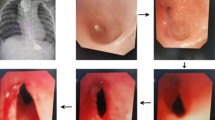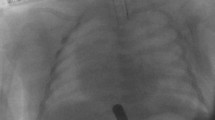Abstract
Anastomotic structure is the most common complication following surgery for oesophageal atresia. The management of this problem provides a continuing challenge to paediatric surgeons. In an effort to reduce the rate as well as the morbidity and mortality associated with oesophageal stricture formation, a regime of routine postoperative prophylactic oesophageal calibration has been undertaken in Princess Margaret Hospital for Children over the last 12 years. Retrospective review of the results of this treatment modality shows low stricture (1.8%) and morbidity rates associated with the procedure.
Similar content being viewed by others
References
Beasley SW, Auldist AW, Myers NA (1989) Current surgical management of oesophageal atresia and/or tracheo-oesophageal fistula. Aust NZ J Surg 59: 707–712
Chittmittrapap S, Spitz L, Keily EM, Brereton RJ (1990) Anastomotic stricture following repair of oesophageal atresia. J Pediatr Surg 25: 508–511
Holder TM (1986) Esophageal atresia and tracheo-esophageal fistula. In: Ashcraft KW, Holder TM (eds) Pediatric esophageal surgery. Orlando, Philadelphia, PA, Grune & Stratton, pp 29–52
Louhimo I, Lindahl H (1983) Esophageal atresia: primary results of 500 consecutively treated patients. J Pediatr Surg 18: 217–229
McKinnon LJH, Kosloske AM (1990) Prediction and prevention of anastomotic complications of esophageal atresia and tracheo-esophageal fistula. J Pediatr Surg 25: 778–781
Myers NA (1979) Oesophageal atresia and/or tracheo-oesophageal fistula: a study of mortality. Prog Paediatr Surg 13: 141–165
Myers NA, Beasley SW, Auldist AW (1990) Secondary oesophageal surgery following repair of oesophageal atresia with distal tracheo-esophageal fistula. J Paediatr Surg 25: 773–777
Myers NA (1991) Evolution of the management of oesophageal atresia from 1948 to 1988. Pediatr Surg Int 6: 407–411
O'Neill JA, Holcolm GW, Neblett WW (1982) Recent experience with esophageal atresia. Ann Surg 195: 739–745
Sillen U, Hagberg S, Rubenson A, Werkmaster K (1988) Management of oesophageal atresia: review of 16 years experience. J Paediatr Surg 9: 805–809
Spitz L, Kiely E, Brereton RJ (1987) Oesophageal atresia: five year experience with 148 cases. J Paediatr Surg 22: 103–108
Touloukian RJ (1981) Long-term results following repair of oesophageal atresia by end to side anastomosis and ligation of the tracheo-oesophageal fistula. J Paediatr Surg 16: 983–988
Author information
Authors and Affiliations
Additional information
Correspondence to: P. A. King
Rights and permissions
About this article
Cite this article
Topuzlu Tekant, G., King, P.A., Gollow, I.J. et al. Prophylactic oesophageal calibration in oesophageal atresia surgery. Pediatr Surg Int 9, 24–26 (1994). https://doi.org/10.1007/BF00176101
Accepted:
Issue Date:
DOI: https://doi.org/10.1007/BF00176101




